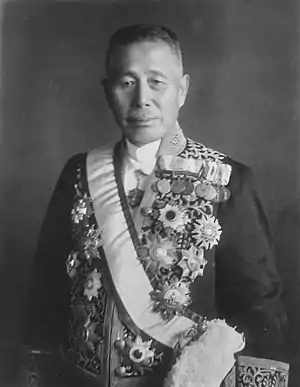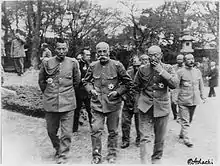Tanaka Giichi
Baron Tanaka Giichi (田中 義一, 22 June 1864 – 29 September 1929) GBE KCMG was a general in the Imperial Japanese Army, politician, cabinet minister, and the Prime Minister of Japan from 1927 to 1929.
Tanaka Giichi | |
|---|---|
田中 義一 | |
 | |
| Prime Minister of Japan | |
| In office 20 April 1927 – 2 July 1929 | |
| Monarch | Shōwa |
| Preceded by | Wakatsuki Reijirō |
| Succeeded by | Osachi Hamaguchi |
| Minister of Foreign Affairs | |
| In office 20 April 1927 – 2 July 1929 | |
| Preceded by | Kijūrō Shidehara |
| Succeeded by | Kijūrō Shidehara |
| Minister of Colonial Affairs | |
| In office 10 June 1929 – 2 July 1929 | |
| Preceded by | Position created |
| Succeeded by | Genji Matsuda |
| Home Minister | |
| In office 4 May 1928 – 23 May 1928 | |
| Preceded by | Suzuki Kisaburō |
| Succeeded by | Mochizuki Keisuke |
| Army Minister | |
| In office 2 September 1923 – 7 January 1924 | |
| Preceded by | Yamanashi Hanzō |
| Succeeded by | Ugaki Kazushige |
| In office 20 September 1918 – 9 June 1921 | |
| Preceded by | Ōshima Ken'ichi |
| Succeeded by | Yamanashi Hanzō |
| Personal details | |
| Born | 22 June 1864 Hagi, Chōshū Domain |
| Died | 29 September 1929 (aged 65) Tokyo, Japan |
| Resting place | Tama Reien Cemetery, Fuchū, Tokyo |
| Political party | Rikken Seiyūkai |
| Spouse(s) | Tanaka Sute (1874–1937) |
| Alma mater | Imperial Japanese Army Academy Army War College |
| Signature |  |
| Military career | |
| Allegiance | |
| Service/ | |
| Years of service | 1874–1924 |
| Rank | |
Early life and military career
Tanaka was born as the third son of a low-ranking samurai family in the service of Chōshū Domain in Hagi, Nagato Province (modern day Yamaguchi Prefecture), Japan. At the age of 13, he participated in the Hagi Rebellion. He had an interest in politics from an early age, serving on a village council and as an elementary school teacher. He only joined the Imperial Japanese Army at the age of 20.
He graduated from the former 8th class of Imperial Japanese Army Academy and the 8th class of the Army War College in 1892, and served as a junior officer during the First Sino-Japanese War. After the end of the war, he was sent as a military attaché to Moscow and Petrograd, and was in Russia at the same time as Takeo Hirose of the Imperial Japanese Navy, with whom he became close friends. Tanaka was fluent in the Russian language, which he learned while attending mass every Sunday at a Russian Orthodox church, which enabled him to practice his Russian at church social events, although it is uncertain if he ever actually converted to Christianity. As one of the few Russian experts within the military, he was an invaluable resource to Army planners during the Russo-Japanese War, and served as aide to General Kodama Gentarō in Manchuria.

In 1906, Tanaka helped draft a defense plan which was so highly regarded by the Imperial Japanese Army General Staff and General Yamagata Aritomo that it was adopted as basic policy until World War I. He was also awarded the Order of the Golden Kite (3rd class) in April 1906.
In 1910, he established a Veterans Association. Tanaka was promoted to major general in 1911, and was made director of the Military Affairs Bureau at the Ministry of the Army, where he recommended an increase in the strength of the standing army by two additional infantry divisions. He was awarded the Order of the Sacred Treasure (1st class) in September 1918. He joined the cabinet of Prime Ministers Hara Takashi as Army Minister from September 1918 to June 1921. He was promoted to full general in 1920 and was awarded the Order of the Rising Sun (1st class). He was also elevated to the title of danshaku (baron) under the kazoku peerage system. However, the Hara cabinet came under unceasing criticism due to the Nishihara Loans, the disastrous Nikolayevsk incident and accusations of Army misappropriation of secret funds, and supporting unsavory figures such as White Movement general Roman von Ungern-Sternberg. After suffering from an attack of angina, Tanaka resigned all posts, and retired to his summer home in Oiso, Kanagawa.
Politician and Prime Minister

Tanaka returned as Army Minister in the 2nd Yamamoto administration from September 1923 to January 1924. After retiring from the army, Tanaka was invited to accept the post of party president of the Rikken Seiyūkai political party in 1925, and was made a member of the House of Peers from January 1926. He had been scheduled to be promoted to the rank of Field Marshal at the time of his retirement. However, when news reached the ears of the Army Ministry of a 3 million Yen bonus that Tanaka received on agreeing to join the Rikken Seiyukai, the promotion was denied.
Tanaka became Prime Minister of Japan on 20 April 1927, during the Shōwa financial crisis, serving simultaneously as the Foreign Affairs Minister. He later added the posts of Home Minister (4 May 1928 to 23 May 1928), and Colonial Affairs Minister (10 June 1929 to 2 July 1929) to his portfolio.
On the domestic front, Tanaka attempted to suppress leftists, Communists and suspected Communist sympathizers through widespread arrests (the 15 March incident of 1928, and the 19 April incident of 1929).
On foreign policy, Tanaka differed from his predecessor Shidehara both tactically and strategically. Whereas Shidehara preferred to evacuate Japanese residents where conflicts occurred with local people, Tanaka preferred using military force. While Shidehara theoretically respected China's sovereignty, Tanaka openly pursued a "separation of Manchuria and Inner Mongolia policy" (満蒙分離政策, Man-Mō bunri seisaku) to create a sense of difference between those areas and the rest of China.[1] On three separate occasions in 1927 and 1928 he sent troops to intervene militarily in Shandong Province to block Chiang Kai-shek's Northern Expedition to unify China under Kuomintang rule, in what became known as the Jinan Incident.
Tanaka came into office even as forces were already beginning to converge that would draw Japan into World War II. In 1928, however, the machinations of the ultranationalist secret societies and the Kwantung Army resulted in a crisis: the assassination of the Manchurian warlord Zhang Zuolin and the failed attempt to seize Manchuria. Tanaka himself was taken by surprise by the assassination plot and argued that the officers responsible should be publicly court-martialed for homicide. The military establishment, from which Tanaka was by now estranged, insisted on covering up the facts of the incident, which remained an official secret. Bereft of support, and under mounting criticism in the Diet and even from Emperor Hirohito himself, Tanaka and his cabinet resigned en masse on 2 July 1929.

Tanaka was succeeded by Hamaguchi Osachi, and died a few months after his resignation. He was awarded the Order of the Paulownia Flowers on his death. His grave is at the Tama Cemetery in Fuchū, Tokyo.[2]
The Tanaka Memorial
In 1929, China accused Tanaka of having authored the "Tanaka Memorial Imperialist Conquest Plan", which advocated the conquest of Manchuria, Mongolia, and eventually the whole of China. He was alleged to have presented the plan to the Emperor in 1927. The plan was presented as fact in the wartime propaganda film series Why We Fight, which claimed that the plan envisaged the conquest of America after East Asia.[3] In a memoir published in the mid-1950s, a Japanese-born Taiwanese businessman, Tsai Chih-Kan, claimed that he had personally copied the "Plan" from the Imperial Library on the night of 20 June 1928, in a covert action assisted by several of Japan's leading pre-war politicians and officers who were opposed to Tanaka. Today, most historians regard the document as a forgery.[4]
Awards and Decorations
From the corresponding article in the Japanese Wikipedia
Japanese
- 1906 –
 Order of the Golden Kite, 3rd class[5]
Order of the Golden Kite, 3rd class[5] - 1918 –
_1Class_BAR.svg.png.webp) Grand Cordon of the Order of the Sacred Treasure[6]
Grand Cordon of the Order of the Sacred Treasure[6] - 1920 –
 Grand Cordon of the Order of the Rising Sun[7]
Grand Cordon of the Order of the Rising Sun[7] - 1929 –
 Order of the Paulownia Flowers[8]
Order of the Paulownia Flowers[8]
Foreign
- 1914 –
 - Bulgaria, Order of Saint Alexander 2nd class[9]
- Bulgaria, Order of Saint Alexander 2nd class[9] - 1918 –
 - China, Order of the Striped Tiger, 2nd class[10]
- China, Order of the Striped Tiger, 2nd class[10] - 1927 –
 - Poland, Order of Polonia Restituta, Grand Cordon[11]
- Poland, Order of Polonia Restituta, Grand Cordon[11] - 1929 –
 - Denmark, Order of the Dannebrog, 1st class[12]
- Denmark, Order of the Dannebrog, 1st class[12] - 1929 –
 - UK, Knight Commander of The Most Distinguished Order of Saint Michael and Saint George (KCMG)[13]
- UK, Knight Commander of The Most Distinguished Order of Saint Michael and Saint George (KCMG)[13] - 1929 –
_Ribbon.png.webp) - UK, Knight Grand Cross of The Most Excellent Order of the British Empire (GBE)
- UK, Knight Grand Cross of The Most Excellent Order of the British Empire (GBE)
Notes
- Hall, John Whitney (1988). The Cambridge History of Japan. 6. pp. 286–287.
- Tama Cemetery
- Dower, John W (1987). War Without Mercy: Race and Power in the Pacific War. Pantheon. ISBN 0-394-75172-8. p. 22.
- 日本批判の根拠『田中上奏文』 中国側 『偽物』認める見解 Archived 2 January 2008 at the Wayback Machine, Tokyo Shimbun, 1 January 2008
- 中野文庫 旧・金鵄勲章受章者一覧
- 『官報』第1850号「叙任及辞令」2 October 1918
- 『官報』第2431号「叙任及辞令」8 September 1920
- 『『官報』第828号「叙任及辞令」1 October 1929
- 『官報』第644号「叙任及辞令」22 September 1914
- 『官報』第1695号「叙任及辞令」30 March 1918
- 『官報』第828号「叙任及辞令」9 October 1927
- 『官報』第777号「叙任及辞令」1 August 1929
- 『官報』第828号「叙任及辞令」1 October 1929
References
- Gluck, Carol. Japan's Modern Myths. Princeton University Press (1987). ISBN 0-691-00812-4
- Hane, Mikiso. Modern Japan: A Historical Survey. Westview Press (2001). ISBN 0-8133-3756-9
- Harries, Meirion. Soldiers of the Sun: The Rise and Fall of the Imperial Japanese Army. Random House; Reprint edition (1994). ISBN 0-679-75303-6
- Morton, William Finch. Tanaka Giichi and Japan's China Policy. New York: St. Martin's Press, 1980.
- Fukagawa, Hideki (1981). (陸海軍将官人事総覧 (陸軍篇)) Army and Navy General Personnel Directory (Army). Tokyo: Fuyo Shobo. ISBN 4829500026.
- Dupuy, Trevor N. (1992). Encyclopedia of Military Biography. I B Tauris & Co Ltd. ISBN 1-85043-569-3.
- Hata, Ikuhiko (2005). (日本陸海軍総合事典) Japanese Army and Navy General Encyclopedia. Tokyo: St. Martin's Press. ISBN 4130301357.
External links
| Wikimedia Commons has media related to Giichi Tanaka. |
| Wikisource has original works written by or about: Tanaka Giichi |